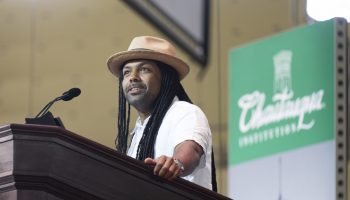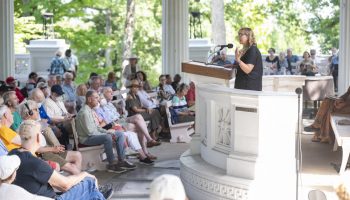
U.S. history, at times, can be a distorted history. Everybody knows that Martin Luther King Jr. “had a dream” — that one day, all people would be free of race-based judgment. It’s a “beautiful aspiration,” according to Debby Irving, but it’s also one that is advantageous to white people.
“This is all I heard, that he had a dream,” Irving said. “And I could say it: That one day we would judge each other by the content of our character and not the color of our skin, which is a beautiful aspiration — and that’s also really convenient for people who want to be colorblind.”
Growing up, Irving, racial justice educator and author of Waking Up White: And Finding Myself in the Story of Race, never knew about King outside of how he was portrayed by white people.
“What I didn’t know about, for instance, with Dr. King was his incredible body of work around power,” Irving said, “and his power analysis, called the ‘triple evils,’ in which militarism, racism and poverty cycle together — it’s kind of a three-part synergy holding racism in place.”
Irving spoke to Chautauquans about her “waking up process” on Monday in the Hall of Philosophy. She began her process after the first inauguration of President Barack Obama in 2009 — a time when she saw people in her “white circles and spaces” who were “clinking wine glasses to being a post-racial country.”
For reasons she couldn’t explain at the time, this didn’t feel right to her. As someone from the Norman Rockwell-esque suburb of Winchester, Massachusetts, she would need to build the necessary understanding and vocabulary to unpack this feeling.
Irving described herself as the U.S. “poster child” of the uninformed, and “waking up white” is how she describes her process of becoming more attuned to race and racism. As a child, she formulated ideas about race without anyone even uttering the word “race” — Winchester was an affluent suburb north of Boston, where talking about racism was considered rude.
“Now, imagine somebody coming to my town and saying to me, ‘Oh Debby, this is where you grew up? My God, all I see is racism,’ ” Irving said.
Had she chosen to respond, Irving would have said something like, “It’s comments like that, that keep (racism) alive. If you would stop talking about it, racism would go away.”
Her childhood normalized Irving into whiteness — everything and everybody around her resembled what she had learned to be all-American, from figures like Rockwell, a white illustrator whose work was regularly featured in publications like The Saturday Evening Post.
“I’m seeing these images, and how convenient for me that what I’m being told is all-American looks exactly like my house — and my neighborhood, and my parents,” Irving said. “Everywhere I go, I’m having my own version of the all-American life being reflected back at me.”
Irving never asked, “Mom and Dad, where is everybody?” She never asked why all her parents’ friends were white, why all her friends were white, why all the teachers and the doctors were white. Not asking these questions is what it means to be normalized into whiteness.
“When I use the term ‘whiteness,’ I don’t just mean the optics of whiteness,” Irving said. “I mean all of the cultural behaviors; the beliefs about what’s right and what’s wrong, what’s appropriate and inappropriate. Who’s beautiful, who’s not. All of those norms are being baked into me and my belief system, without me knowing it.”
And like many children, she was taught to be polite, to never complain or be unpleasant. Talking about politics and religion, which are foundational to the perpetuation of racism, in polite company was, and still is, considered taboo, which severs any and all pathways to discussing racism.
“These are ways that I remained in an information vacuum my entire childhood,” Irving said.
This was the post-World War II era, amidst prevalent rhetoric about the possibilities of people from all over the world coming to America and seeking refuge. The United States was portrayed as a safe harbor for all people — those willing to put in the hard work necessary — to pursue the American Dream.
Because of her surroundings and environment, Irving unconsciously bought into the idea that one particular type of person — a white, cis, Christian man — was naturally, or biologically, more valuable than others.
“I think we need to meet the times where we are, and we are in a very tense time,” Irving said. “I am not going to mince words — I want to give you what my definition of ‘white supremacy’ is.”
Despite being raised by loving people, she believes that she was raised in a white supremacist household; a household that upheld the ideology that all people are not created equal. That white people are superior to others. And the modern era continues to uphold the idea that certain people have more value than others — Irving told Chautauquans to “merely look at the currency” in their wallets.
From day-to-day interactions, like Irving standing up at book signings to shake the first white man’s hand that she encounters, to the whitewashing of important historical moments and information, white supremacist ideology runs deep in American life.
The chosen narrative of King is just one example. Other aspects of American history, such as “Black Wall Street,” a thriving and affluent black neighborhood in Tulsa, Oklahoma, in the early 20th century where numerous successful businesses existed, have been left out of the American historical narrative.
If people, like Irving, don’t understand Black Wall Street’s proliferation and ultimate disintegration as a result of white rage, in addition to the hundreds of situations that have disadvantaged black people, then they are “sitting ducks” in the level of discrimination present in the United States.
“The other thing that I am a sitting duck for is not even seeing the systems that have been structured all around me to advantage families like mine,” Irving said. “I don’t know anyone who had a harder time wrapping their heads around systemic racism than me. The thing that finally helped me understand it has to do with the G.I. Bill.”
Officially known as the Servicemen’s Readjustment Act of 1944, the G.I. Bill was designed to benefit World War II veterans in a number of areas, such as housing and education.
“I want to focus on the housing portion of the G.I. Bill,” Irving said. “Black and brown veterans were largely cut out of the G.I. Bill, even though it said nowhere in it that it was a white-only bill, because there were already barriers all through U.S. systems that made it nearly impossible for black and brown returning veterans to access it.”
These preexisting barriers stem back to the Great Depression, when the New Deal took a heavy focus on erecting new housing and infrastructure across the country.
“(The suburbanization of the U.S.) is all happening, and the FHA, the Federal Housing Authority, and also a loan-arm of the government, got created because, ‘How do we get people coming out of a depression to buy a home?’ ” Irving said. “We have to make a loan, and that loan gets named the mortgage.”
With the mortgage, the FHA needed a set of risk guidelines to assure the government and banks didn’t lose out on their loans.
“The FHA decides — and writes this into their document — that the presence of even one or two non-white families can undermine real estate values,” Irving said. “And so with that government warning in mind, private banks all over the country lay out maps of their cities and towns, and they engage in a practice known as redlining.”
Black neighborhoods were the ones redlined, or the ones whose residents were systematically denied financial services, leaving white neighborhoods to be advantaged.
Filling in these historical gaps, Irving said, allows people to change their perceptions on economic inequality, which didn’t result from white people working harder than others, but rather four centuries of governmental policies that have “intentionally and unintentionally diverted wealth to white, wealthy people again and again and again.”
History has been hiding in plain sight, according to Irving.
“It’s a horrific history,” Irving said, “and the longer we deny it, I believe the more horrible it becomes, and I’m all for leaning into that now.”
Irving said she believes in shifting resources, and that reparations have to be “both material and psychological.” But she also said there’s more internal work that white people can start now and continue to work on every day: to normalize talking about race in a productive and progressive manner; to understand the prejudices and social normalization that not only live within society, but also oneself; and to understand that this work is a layered journey.
“I have come to love the truth, no matter how painful — and it can be incredibly painful — because of that old adage that ‘the truth will set us free’; there’s also something about when the truth gets told,” Irving said. “It unleashes a kind of energy that propels us to the next layer.”





